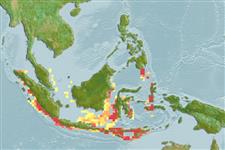>
Eupercaria/misc (Various families in series Eupercaria) >
Nemipteridae (Threadfin breams, Whiptail breams)
Etymology: Nemipterus: Greek, nema, -atos = filament + Greek, pteron = wing, fin (Ref. 45335).
More on author: Bleeker.
Environment: milieu / Klimaatzone / Diepte / distribution range
Ecologie
marien demersaal; standvastig; diepte 50 - 150 m (Ref. 9785). Tropical; 6°N - 11°S, 94°E - 128°E (Ref. 3810)
Indo-West Pacific: southern Indonesia, Sumatra to Flores. This species is very similar to Nemipterus bathybius.
Grootte / Gewicht / Leeftijd
Maturiteit: Lm ? range ? - ? cm
Max length : 18.0 cm SL mannelijk / geslacht onbekend; (Ref. 3810); common length : 12.0 cm SL mannelijk / geslacht onbekend; (Ref. 3810)
Dorsale stekels (totaal) : 10; Dorsale zachte stralen (totaal) : 9; Anale stekels: 3; Anale zachte stralen: 7. Suborbital spine absent. Preopercle with 3 transverse scale rows. Pectoral fins long, reaching to or almost to level of origin of anal fin. Pelvic fins moderately long, reaching to or just beyond anus. Upper lobe of caudal fin produced into a short trailing filament. A line drawn upwards from the posterior edge of suborbital reaching the dorsal profile 2 to 5 scale rows before origin of dorsal fin. Axillary scale present. Color: Upper body pinkish, pearly white below. Compared to N. bathybius, this has a more or less straight caudal filament; is more slender and differs in color pattern: lower lateral stripe originates from above the pectoral-fin base; dorsal fin lacks undulating yellow lines; and upper caudal fin and filament red-edged.
Body shape (shape guide): fusiform / normal; Cross section: oval.
Occurs on sand or mud bottoms. Rarely seen in less than 50 m depth (Ref. 48635).
Levenscyclus en paargedrag
Maturiteit | Voortplanting | Paaien | Eieren | Fecunditeit | Larven
Russell, B.C., 1990. FAO Species Catalogue. Vol. 12. Nemipterid fishes of the world. (Threadfin breams, whiptail breams, monocle breams, dwarf monocle breams, and coral breams). Family Nemipteridae. An annotated and illustrated catalogue of nemipterid species known to date. FAO Fish. Synop. 125(12):149p. Rome: FAO. (Ref. 3810)
Status op de Rode Lijst van het IUCN (Ref. 130435: Version 2025-1)
Gevaar voor de mens
Harmless
Gebruik door de mens
Visserij: visserij voor eigen gebruik
Tools
Speciale rapporten
Download XML
Internetbronnen
Estimates based on models
Preferred temperature (Ref.
123201): 23 - 28.1, mean 25.2 °C (based on 19 cells).
Fylogenetische diversiteitsindex (Ref.
82804): PD
50 = 0.5000 [Uniqueness, from 0.5 = low to 2.0 = high].
Bayesian length-weight: a=0.01349 (0.00626 - 0.02905), b=2.96 (2.79 - 3.13), in cm total length, based on LWR estimates for this Genus-body shape (Ref.
93245).
Trofisch niveau (Ref.
69278): 3.8 ±0.5 se; based on size and trophs of closest relatives
Weerstandsvermogen (Ref.
120179): Hoog, minimale populatieverdubbelingstijd minder dan 15 maanden (Preliminary K or Fecundity.).
Fishing Vulnerability (Ref.
59153): Low vulnerability (12 of 100).
🛈
